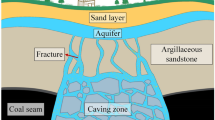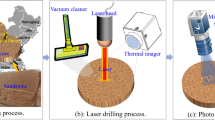Abstract
The phenomenon of water–sand outburst often occurs when the tunnel passes through the sand texture layer. In the process of water–sand outburst, the sand bodies of large particles are accumulated above the cracks of the tunnel under the squeezing effect of each other, and the phenomenon of particle arching occurs, thereby forming a stable contact force arch. With the diameter of the tunnel cracks increases, stable contact force arches cannot be formed between the sand particles. In this paper, by analyzing the occurrence mechanism of water–sand outburst disasters, three arrangement models of particles were established when the interlocking arch was formed, and the critical ratio of cracks to particles when the force arch was destroyed was obtained by theoretical derivation. The results show that the critical ratio was only related to the internal friction angle of the sand body itself. When the ratio of cracks to particles does not exceed the critical ratio, a stable contact force arch will be formed, and the continuous water–sand surge will not be induced basically; once the ratio of cracks to particles exceeds the critical ratio, stable contact arches will not be formed. Unstable contact force arch can easily induce water–sand outburst disasters. As the ratio of cracks to particles increased, the damage degree of water–sand outburst disaster increased.






Similar content being viewed by others
References
Dai X (2016) Experimental and theoretical research on the evolutionary mechanism of sand leakage disaster in urban underground engineering. Tianjin University (Degree) (in Chinese)
Г.К, G Column, Chen DP, Wang RJ et al (1960) Structural mechanics of loose bodies. People’s Railway Publishing House (Monograph)
Liang Y, Tan ZD, Li GJ (1996) Simulation experiment of water inrush and sand inrush in weakly consolidated sand layer. J Xi’an Highway Commun Univ 01:19–22 (in Chinese)
Lu ZH (1991) Mechanism analysis of arch formation by outlet flow of granular agricultural materials. Chin J Agric Eng 01:78–85 (in Chinese)
Marinelli J, Carson JW (1992) Solve solids flow problems in bins, hoppers, and feeders. Chem Eng Prog 88(5):22–28
Schulze D (2008) Powders and bulk solids—behavior, characterization, storage and flow. Springer, Berlin (Monograph)
Tian YS (2013) Experimental and numerical study on the arch formation of spherical particles in silo. In: China mechanics conference—abstracted collection of 2013 papers. Chinese Society of Mechanics, Xi’an Jiaotong University: Chinese society of mechanics, p 341 (in Chinese)
Wang Q (2011) Theory and experimental study of active activated silo system based on biplast vibration. China University of Mining and Technology (Beijing) (Degree) (in Chinese)
Xie Y, Han BH, Cheng ZG, Duan YL (2013) Numerical simulation of arch forming and fluid modification in hopper. Comput Simul 30(08):221–224 (in Chinese)
Xu Y. (2012) Experimental research on the arch of pellet flow, Computational mechanics committee of Chinese society of mechanics. Research progress of computational mechanics of pellet materials. Computational mechanics committee of Chinese Society of Mechanics: State Key Laboratory of Structural Analysis of Industrial Equipment, Dalian University of Technology, pp 462–467 (in Chinese)
Yang WF, Ji YB, Zhao GR, Shen DY (2012) Characteristics of water-sand flow migration induced by mining of thin bedrock in thick and loose beds. J Geotech Eng 34(04):686–692 (in Chinese)
Zhang X, Liu CY, Chen BW (2017) Experimental study on sedimentation induced by sand inrush in near-loose bed. J Water Conservancy Constr Eng 15(06):116–121 (in Chinese)
Zheng G, Dai X, Zhang XS (2014) Experimental study and numerical simulation of development process of sand leakage disaster in underground engineering. J Rock Mech Eng 33(12):2458–2471 (in Chinese)
Acknowledgements
This work was supported by Excellent Talents Fund Program of Higher Education Institutions of Liaoning Province (No. LR2018053) and the National Natural Science Foundation of China (51774199).
Author information
Authors and Affiliations
Corresponding author
Additional information
Publisher's Note
Springer Nature remains neutral with regard to jurisdictional claims in published maps and institutional affiliations.
Rights and permissions
About this article
Cite this article
Wang, Z., Wang, J., Wang, A. et al. Analysis on the Instability of Interlocking Arch Induced by Water–Sand Outburst in Tunnel Lining Cracks. Geotech Geol Eng 39, 451–459 (2021). https://doi.org/10.1007/s10706-020-01503-2
Received:
Accepted:
Published:
Issue Date:
DOI: https://doi.org/10.1007/s10706-020-01503-2




